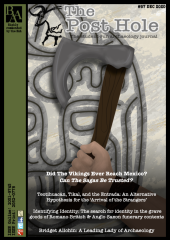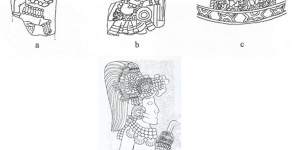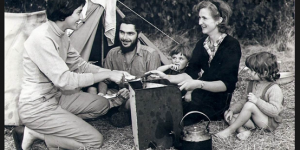Introduction
Discussions on pre-Columbian and pre-Conquistador visits to mainland America bring up a number of concerns even before tackling the unreliable backgrounds a number of “white saviour” stories have. For one, it is only recently in the 1980’s that any concrete proof has been discovered that Europeans arrived on the American continent centuries before Christopher Columbus laid eyes on its tropical shores (Ingstad & Ingstad 1991).
Aside from the aforementioned site; L’Anse Aux Meadows, a short-lived Norse settlement in Newfoundland, Canada, there is also dubious evidence that the existence of new world Nicotine in old world Egyptian mummies “proves” that the Egyptians, whose boats famously struggled to cope with the humble waters of The Meditteranean, somehow managed to reach the Americas long after the Bering Land Bridge had disappeared (Fagan 2013; Faulkner 1941; Gorlits 2016).
Also worth mentioning is Patricia Sutherland’s research into the theorised Norse settlement at the very Northern tip of Baffin Island, and presumed trade with the native Dorset people, sometime between the 11th and 13th century (Hamilton 2013).
In short, the only concrete evidence of pre-Columbian travel to the new world is L’Anse Aux Meadows, and that encompasses only an island or three off of the coast of Canada - hardly the rainforest traipsing triumphs of Christopher Columbus down in Cuba and Mexico. Still, these Vikings settled in North America around five hundred years before Columbus had even set foot on a boat, but this fact wasn’t accepted until physical evidence was found (Ingstad & Ingstad 1991).
The Icelandic Sagas & Vinland
Prior to the discovery of the L’Anse Aux Meadows site in the 1960’s, the only real hints towards any form of Norse occupation anywhere in America came from the Icelandic Sagas, themselves likely originating from oral stories passed down through the generations beforehand, telling of three separate voyages between Greenland and a place called Vinland.
According to these sagas, written by Medieval authors around the 13th century, Leif Erikson follows the directions from a merchant named Bjarni, who had mistakenly arrived at an undiscovered land after being blown off course during a voyage in 986 (Wernick 1979). In the very same knarr, a form of Norse merchant vessel, Leif traces the same route in 1001, and discovers three distinct lands (Þórðarson 2019).
They were Vinland, meaning “wine land”, Markland, meaning “forest land”, and Helluland, meaning “land of the flat stones”. It has been a contested topic which of these three lands is L’Anse Aux Meadows, but it is most likely Vinland, with the comparatively barren Baffin Island and the wooded coasts of Labrador being Helluland and Markland respectively (Fig. 1).
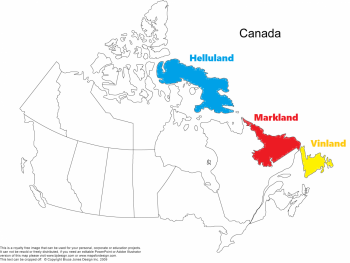
along with the location of Newfoundland in which the L’Anse Aux Meadows site is located.
These sagas then tell of a subsequent settlement somewhere in the area, now assumed to have been the L’Anse Aux Meadows site, followed by two separate voyages from two different Greenlanders, one of whom’s heavily pregnant wife wards off an attack from the native Skraelings (presumably the Thule people) by slapping her left breast with a sword; to make some statement on the dramatism of these sagas (Magnusson & Palsson 1965).
In any case, any form of permanent Norse settlement in Canada likely stopped in 1010 after the Battle of Vinland which is, again, an event only known from semi-fictional or possibly entirely fictional Icelandic Sagas (Kunz 2001).
As for the facts, we now know via archaeological evidence that the Norse were in Newfoundland until 1010 when the site was abandoned, and that timber-gathering voyages to Markland - or rather Labrador - may have continued from Greenland to as late as the 14th century before the Western settlement disappeared (Schledermann 1996; Sutherland 2000).
But these findings were all borne from brief snippets and details describing an otherworldly land in the Icelandic Sagas, which are relatively untrustworthy as a sole source of information due to their blending of historical fact and fiction (Kunz 2001).
So if an entire Norse settlement in Newfoundland was discovered following initial doubt from academics based solely on the sagas alone, could this phenomenon not occur a second time?
The following section will explore the theory that Vikings from Iceland and Ireland sailed to and from the Yucatan Peninsula, Mexico, between the years 998 and 1030; their impact on the resident Toltec and later Aztec culture, and the fors- and againsts- of the argument overall.
The Journeys To “Mexico”
It is the Icelandic Sagas which first describe the voyage to Vinland, and it is in these same pages we see reference to a similar journey to a bizarre land further South, one of treacherous reefs, strange peoples, and devout worship (Valdimarsdóttir 1999).
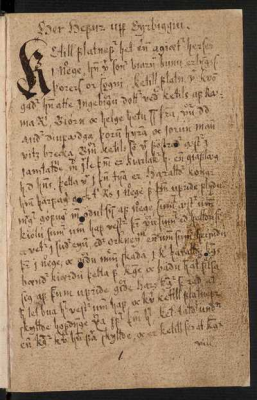
The story of how Leif Eriksson discovered America is one involving him escaping the law of Greenland on manslaughter charges. It sounds, at least on the surface, like something more fitting to History Channel’s Vikings, rather than reality. Nevertheless, even if Leif wasn’t a fugitive on the run, he still definitely discovered America - or at least followed the advice of Bjarni who had previously discovered it (Kunz 2001).
Now, the story of how Björn Breiðvíkingakappi, an Icelandic Viking, eventually wound up in what is assumed to have been Toltec Yucatan, is one involving a deadly love affair between him and his rival’s wife (Böldl 1999). In order to prevent further bloodshed resulting from the two blokes being on the same massive island together, Björn sets sail from Iceland in 998, and that is the last we hear of him.
Until many years later in 1030, when a later Scandinavian Gudleif and his crew sailed West around Ireland on a merchant voyage, and after many storms at sea and days stranded, arrived at a strange place where they were greeted by men assumed to be speaking Irish (Valdimarsdóttir 1999). A mystical place across the Atlantic known only as “Great Ireland” or “Ireland The Greater” has long been referenced in historical texts as far back as 93 year-old Irish monk Brendan of Clonfert apparently sailed across the Atlantic to a paradise, and back again, sometime in the fifth century (Klein 2014; Geoffrey 1971). In fact, it is referenced in the Icelandic Sagas that the Vikings were already aware of previous Irish travel to beyond Vinland, hence the origin for the term “Great Ireland” to describe said location. This is however just as dubious as the central Vikings in Mexico tale.
Moving forward from Brendan’s voyage however, it is in 1030 when Gudleif and his crew were apparently apprehended by the natives and thought to be nearly executed, but not before they were brought to their leader who turned out to be a familiar sight; a bearded white skinned man. Although never mentioned by name in the chapter on Gudleif, this bearded man ends up being able to speak Norse, and asks about his contemporaries back home in Iceland; the woman he so desperately loved, and her husband.
It is only after being allowed to leave and on their arrival back home that Gudleif comes to the assumption that the mysterious chieftain worshipped by the natives, assumed in this case to be Toltec people, was indeed the enigmatic Björn, who had vanished from Iceland decades prior (Valdimarsdóttir 1999).
Naturally, given the period in which these sagas were written - over a hundred years before Columbus set sail - they never explicitly mention the name of the land Björn and Gudleif find themselves in. The word “Mexico” is not seen anywhere on these sources, nor the words “Toltec”, “Aztec”, “Mayan”, “Quetzalcoatl”, and so on. There has also been zero physical evidence thus far of the Norse culture influencing or interacting with the native Toltec and later Aztec beliefs. As such, there is nothing concrete to prove anything written in the saga of Bjorn and Gudleif, but that was the case before L’Anse Aux Meadows was discovered, too.
In fact, the only further information we have to go on to discuss a Norse presence in the Yucatan Peninsula is just a handful of coincidences and speculations, but when has that ever stood in the way of sensible and restrained theorising?
So long as a level head is kept, and one acknowledges the fictional nature of the Icelandic Sagas, then diving into this topic in a purely speculative nature is harmless.
Discussion
There are various fors- and againsts- for the argument that the Vikings reached Mexico; one must first consider the sheer distance between Iceland, which is the proposed origin point of this journey, and Yucatan itself, and all of the obstacles that lie between.
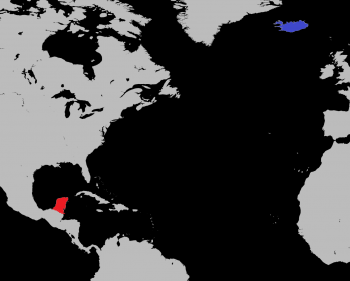
To get from Iceland to Mexico you would have to travel over 3,616 nautical miles over the course of ten days, and that's in an almost perfect diagonal line, based on the proposed top speed of a medium-sized Viking longship in favourable conditions of 28 km/h, and completely unbroken through night and day (Magnusson 2016). This isn’t taking into account the various weather conditions, rogue waves, poor or zero wind, or other landmasses one would potentially bump into along the way, possibly adding or subtracting any number of hours or days from the total voyage time.
Also, nowhere in the Icelandic Sagas covering Björn and Gudleif’s journeys does it specify the size of their vessel, so that must also be taken into account. Neither Björn nor Gudleif ever reach any landmass other than what is assumed to be Yucatan, for that matter, which is remarkable considering to reach Mexico from Iceland via the shortest possible route one would have to traverse the Straits of Florida, and that's after navigating your way around The Bahamas (Fig. 4).
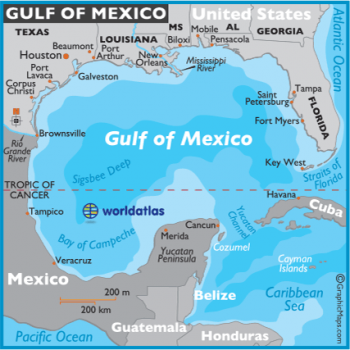
The fact no other islands are mentioned in the story is perhaps not a definitive indicator that the journey was fictional, for it is possible that by pure luck neither Björn nor Gudleif encountered anything else, or rather more likely that they just didn’t think of mentioning anything else when they returned home and recounted the story to their children. It is also possible extra details of the original stories the Icelandic Sagas are based on, if they did exist in the first place, had just faded through the generations before they were written down in the 13th century (Kunz 2012; Valdimarsdóttir 1999).
There is also the possibility neither Björn nor Gudleif ever visited Mexico and the Toltec, and it was instead another culture on an entirely separate piece of land they both miraculously encountered.
So why is it that the Toltec and later Aztec culture are believed by some to have been the mysterious “Great Ireland”-ers who worshipped Björn and made him their chief. That answer lies in the work of Þorunn Valdimarsdóttir and various Mexican researchers, painstakingly analysing similarly vague semi-fictional Aztec documentary sources for connective tissue between them and the story of Björn (Valdimarsdóttir 1999).
White saviour narratives aside, with the obvious potential for Hernando Cortez et al to have meddled with native Aztec myth also ignored, it was believed by the worshippers of Quetzalcoatl - which includes the Mayans, Toltec, and various other pre-Columbian cultures, that he would one day return after ten cycles of their calendar following his first appearance (Anderson & Dibble 1982).
Said Meso-American calendar is widely regarded as incredibly accurate when compared to written records and dates from Mexican history, as it measured time based on the position of the sun and the moon, and each cycle was almost perfectly 52 regular years, making ten cycles 520 years (Coe 2015). This will be relevant later.
It is also known that Quetzalcoatl means “feathered serpent” in native Aztec tongue, and that he abhorred human sacrifice, and apparently had the capacity to appear as a white skinned individual. According to the Mexican annals, whose dates are unclear beyond him having started his reign in the tenth century, there was also a Toltec ruler by the name of Ce Acatl Topiltzin, which roughly means Quetzalcoatl, often assumed to have been another moniker for Ce Acatl. Again, that may just be an assumption based on the fact a large amount of Toltec history was lost due to the Conquistadors, and so the fact Quetzalcoatl and Ce Acatl are similar might be an instance of occam’s razor (Leon-Portilla 2003; Valdimarsdóttir 1999).
So currently on the table we have the belief that Quetzalcoatl (a white skinned god) would return 520 years after his initial arrival, a legendary chieftain from Toltec history who shares the same title, and a few visual similarities such as the fact Viking longships were commonly adorned with dragon figureheads, the sight of which does certainly connote serpent-esque descriptors. Björn, who would have been the sole sailor of his dragon-headed vessel, was then named by the Toltec after where he came from - not Iceland, but his boat; the serpent.
Björn, now “Quetzalcoatl”, became the leader of the Toltec people and shaped their culture moving forward with various “otherworldly” ideals.
Naturally there is a suspension of disbelief needed to take this fairy-tale-esque series of events seriously, and a lot of coincidences do occur across multiple cultures in the world. One such change Quetzalcoatl is said to have made which revolutionised Toltec culture was the addition of supporting pillars in structure building, a common occurrence in Norse architecture, and one previously unseen in Meso-American up to that point (Soustelle 2002). Much like with the theorised Norse-Dorset settlement excavated on Baffin Island by Patricia Sutherland, in which evidence of twining string to strengthen it was believed to be proof of Norse interaction, for the natives had never done that before, was then disproven due to the fact that it was not likely to take a whole separate culture migrating into an area for the indigenous population to figure out the strength of twining string (Hamilton 2013).
It is also said that Quetzalcoatl introduced the idea of warriors who die in battle joining their gods in the afterlife; a clear similarity between the beliefs of the Aztecas and the Norse, but again not a belief that couldn’t have just emerged convergently (Soustelle 2002; Valdimarsdóttir 1999). Likewise, the notion that Quetzalcoatl apparently requested he be burned on a pyre after death isn’t necessarily unique to Vikings only, nor is the idea of sacrificing animals instead of humans, a trait Quetzalcoatl is also credited with starting.
All of this could well be just a coincidence, lots of coincidences, much in the same way that 520 years (or ten cycles) of the Meso-American calendar from 998 is 1518, the year Hernando Cortez set sail to Mexico and began the conquest of the New World. It is worth noting that it is written in admittedly dubious Spanish contemporary documents that Cortez was welcomed by Moctezuma II of the Aztecs as the return of Quetzalcoatl, and there was no blood spilt until later (Morgunblaðsins 1998). On that note, there is the likelihood these Spanish sources are just lying and fictionalising Cortez’ invasion on Aztec soil; making carnage seem more peaceful by bastardising elements of already vague native beliefs.
All that said and done, even if these similarities and written events are just a string of coincidences, it is the very same collection of fairy-tales and fictionalised events which led to the eventual discovery of L’Anse Aux Meadows, which was beforehand pushed aside as mere fiction.
Conclusion & Acknowledgements
Dismissing these coincidences as just that without any further study is not helpful to anyone, nor is just an article written by an undergraduate unspecialised student enough to truly delve into the topic. As Þorunn Valdimarsdóttir stated at the end of her article in 1999, which inspired this very piece; “[The Icelandic Sagas] account of how Björn the champion of the Broadwickers became a chieftain in the New World humbly begs for attention. It needs to be considered by specialists of pre-Columbian history in connection with the Quetzalcoatl lore.”
I would like to offer special thanks to Þorunn Valdimarsdóttir who kindly allowed me to use her research to form the basis of this article; it was her study into this matter which initially prompted my interest in this area of quasi-history.
Likely, there will never be a definitive answer on whether or not the Vikings ever reached Mexico, for what is described in the Sagas, if they can be believed, is nothing more than a temporary visit by Gudleif, and a cultural assimilation by Björn, neither of which would leave any concrete archaeological evidence.
Until this is proven by concrete evidence of Scandinavians in Mexico, then this fable will remain just that; a story, and an entertaining but very unlikely one at that.


